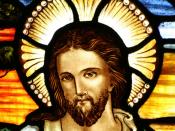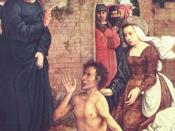The poem and the drawing are divided into two unequal parts. The first portion of the poem (three stanzas) is devoted to stating and answering the question, "Are people compassionate toward one another?" One third of the artwork represents the struggle of humans and the compassion of humans toward one another. The second portion of the poem (six stanzas) is devoted to posing and answering the question, "Is God compassionate toward people who are hurting?" and presenting an argument on the goodness of God toward suffering humanity. Two-thirds of the space available for artwork on the copperplate is devoted to a vine and birds representing the presence and care of God.
The poem and the artwork stand in juxtaposition to one another in their symmetry and lack thereof. The poem has an extremely clear pattern. The drawing has a sense of randomness. The poem shows life as we would like it to be.
The drawing shows life as it is. Blake seems to be using these two mediums to expand the consciousness of the individuals who will be reading and viewing his work.
In contrast, the artwork appears random in its progress (though certainly it is not). The heavy vine on the right seems to be growing aimlessly with large and small leaves thrown side by side. It does not give the feeling of growing up or out, but rather seems stray, unkempt. The casualness of the plant is further presented in the mixing of brown and green leaves. Is it fall or spring? The growth intertwining the people is not a strong structure like a good climbing tree, but is like a grapevine tended by a gardener with a decidedly brown thumb.
Blake shows a very high opinion of the human race in both his words and his etchings. He asked the question about whether a person could see another person suffering and not suffer with him. His answer was a resounding, "No, no! never can it be! Never, never can it be!" Blake also shows a very high opinion of God in His relationship with man. He states clearly that God cares for us as a parent cares for a hurting child (Weeping tear on infantáæs tear). He rejects the image of God as judge and presents the image of God as friend. Perhaps he was recalling the death of Jesusáæ friend, Lazarus, when Jesus went to comfort the grieving sisters, Mary and Martha. John 11:35,36 says, "Jesus wept. Then the Jews said, 'See how he loved him!'" Blake unites the two sides of his drawing across the bottom and the top through the green earth on the bottom and the intertwining vine on the top. The structure frames the work and shouts its message: Our lives are interconnected with one another and with God.




